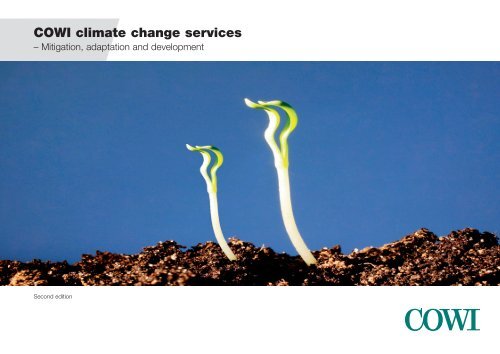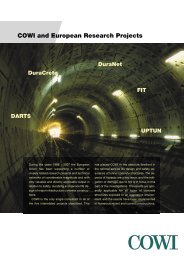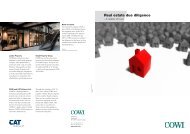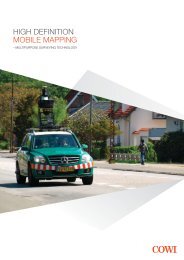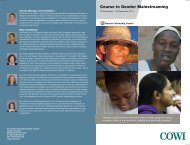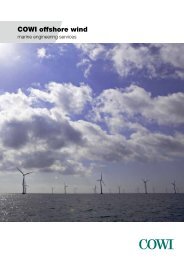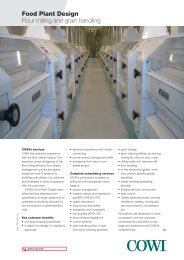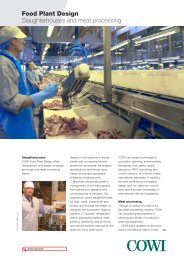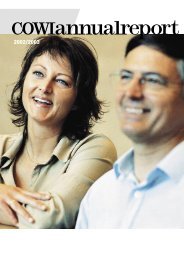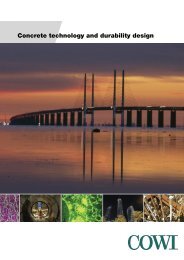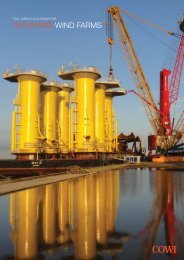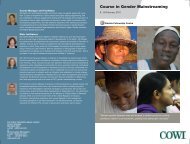COWI climate change services (pdf)
COWI climate change services (pdf)
COWI climate change services (pdf)
You also want an ePaper? Increase the reach of your titles
YUMPU automatically turns print PDFs into web optimized ePapers that Google loves.
2Introduction<strong>COWI</strong>'s <strong>climate</strong> <strong>change</strong> agenda<strong>COWI</strong> acknowledges the increasingglobal consensus about the importanceof fast interventions and innovative solutionswithin the <strong>climate</strong> <strong>change</strong> agendaand the expected demands of a lowcarbon economy. <strong>COWI</strong> has endorsedthe <strong>climate</strong> initiative, Caring for Climate,under the UN Global Compact.We focus our business developmenttowards being a leading consultantdeveloping future <strong>climate</strong> <strong>change</strong> mitigationmeasures and adaption solutions insectors and regions where we have astrong foothold.<strong>COWI</strong>’s strategy on <strong>climate</strong> <strong>change</strong>communicates the ambition to involveour global company network in creativeand innovative cooperation with ourcustomers worldwide.<strong>COWI</strong>’s 3E profile – engineering,environment and economics – providesa strong platform for multidisciplinary,balanced mitigation and cost-effectiveadaptation solutions to <strong>climate</strong> <strong>change</strong>in many sectors. With this brochure, weprovide an overview of our competenceprofile.<strong>COWI</strong> contributes actively to reducing and documenting our global<strong>climate</strong> impact from our activities in mitigation as well as adaptation:• We will actively evaluate potentials for andcontribute to optimal <strong>climate</strong> solutions in partnershipwith our customers• We will reduce our in-house and on-project<strong>climate</strong> impact through carbon-conscious policiesand potential carbon off-setting in respect ofthe efficiency needs of our customers and ourorganisation• We will promote voluntary participation in our<strong>climate</strong> initiative and provide tools for improvedindividual <strong>climate</strong> behaviour in partnership withour employees.@ R&DDirectorStig P. Christensenspc@cowi.comwww.cowi.com/<strong>climate</strong>@Photo: Niels Åge Skovbo
3<strong>COWI</strong> <strong>climate</strong> <strong>change</strong> <strong>services</strong><strong>COWI</strong> provides multidisciplinary <strong>services</strong> for adaptationand mitigation projects worldwide. The bricks represent<strong>COWI</strong>’s adaptation and mitigation <strong>services</strong>.Both are presented in this brochure.Riskanalysis andplanningPolicy,strategiesand planningTransportanalysis andplanningEnergyplanning = greenhousegas reductions+ savingswww.cowi.com/<strong>climate</strong><strong>services</strong>@Water, floodingand extremeweatherInfrastructure,buildings andnatureMitigation and AdaptationCoastalEnergyprotectionefficiency inindustry andbuildingEnergyproductionCarbonmanagement,footprint andfinancingPolicy, strategies and planningTransport analysis and planningEnergy planning = greenhouse gas reductions + savingsEnergy productionCarbon management, footprint and financingEnergy efficiency in industry and buildingsCoastal protectionInfrastructure, buildings and natureWater, flooding and extreme weatherRisk analysis and planning
5Put your own house in order...Photo: Mogens CarrebyeNational <strong>climate</strong> <strong>change</strong> strategy for RomaniaRomania is taking its first steps towards a targeted andcoordinated national drive to limit emissions of greenhousegases and to deal with the anticipated impactsof <strong>climate</strong> <strong>change</strong>.The focus of Romania’s approach to <strong>climate</strong> <strong>change</strong> ison the requirements resulting from the country’s membershipof the EU (including participation in the EU EmissionsTrading Scheme) as well as from its international commitmentsunder the United Nations Framework Conventionon Climate Change (UNFCCC) and the Kyoto Protocol.The technical assistance <strong>COWI</strong> has provided for updatingRomania’s national strategy action plan on <strong>climate</strong><strong>change</strong> relates to adaptation to <strong>climate</strong> <strong>change</strong> and tolimiting Romania’s emissions of greenhouse gas throughmitigation policies.“The main task as far as adaptation is concernedhas been to improve knowledge andidentify ‘no regrets’ and cost-effective precautionaryadaptation measures.”Market Director Claus Hvashøj Jørgensen.”The results have significant politicalimplications, of course, and <strong>COWI</strong> willtherefore be emphasising the needfor our conclusions to be founded inrobust data.”Senior Project Manager Dinne Smederup Hansen.Photo: Andrew Stewart/Cappelen PhotoThe sky is crying,but I have a plan...www.cowi.com/<strong>climate</strong><strong>services</strong>@Evaluation of Least Developed Countries’ <strong>climate</strong> plansHow will Bangladesh manage floods resulting from rising ocean levels? Andhow are West African countries to tackle desertification if the rainy seasonbecomes shorter in the future?These are just some of the questions which 44 <strong>climate</strong> adaption actionplans from the Least Developed Countries Fund provide answers to. Theplans are now set to be analysed by <strong>COWI</strong> in an international evaluationproject.The <strong>climate</strong> adaption plans have been drawn up since 2005 for countriessuch as Afghanistan, Nepal, Angola and the Solomon Islands. <strong>COWI</strong> will beexamining the quality of each action plan individually and to what extentlocal governments and NGOs have been involved, as it reflect the potentialto attract the funding needed to implement the plans.Policy, strategies and planningTransport analysis and planningEnergy planning = greenhouse gas reductions + savingsEnergy productionCarbon management, footprint and financingEnergy efficiency in industry and buildingsCoastal protectionInfrastructure, buildings and natureWater, flooding and extreme weatherRisk analysis and planning
6Transport analysisand planningFactsToday, most of the world’s population live in citieswhere road traffic is increasing dramatically. Urban<strong>climate</strong> solutions are needed that combine sustainableurban planning with well-organised infrastructure.World trade has developed dramaticallyas well and will continue to do so in the future.<strong>COWI</strong> helps national and regional public bodiesand businesses to analyse future transport patternsand make planning for this development.With the growth in the transport sector, greenhousegas emissions follow. In spite of graduallyincreasing energy efficiency in vehicles, shipsand airplanes, the growing demand for transportmore than outweighs these improvements.Reduced emissions from transport can beachieved through more efficient transport,reduced growth in transport demand, reducedgreenhouse gas emission from energy use intransport, optimized infrastructure designs andspatial planning.At government level, <strong>COWI</strong> provides a combinationof visionary physical planning and efficienttransport planning to establish the right frameworkfor long term sustainable mobility in cities,municipalities and regions. This is combined withpolicy measures, e.g. new transport sector regulationsand <strong>change</strong>d tax schemes, to reach intelligenttransport systems that ensures optimaltraffic and utilization of roads. Such measureswill also increase the use of public transport andintroduce new low-carbon transport possibilities.For businesses, it is vital to optimize logistics forthe individual company and all the way throughthe supply chain to lower costs and greenhousegas emissions. <strong>COWI</strong> helps businesses optimisetheir logistics and vehicle fleet. This could entailthe possibility for companies to <strong>change</strong> businessstructure to get closer to their customers.@ SeniorProject ManagerHenrik Duerhdu@cowi.comSenior Project ManagerHenrik Grellhgr@cowi.com
7How to get fromA to B to C to...Transport planning to comply withcustomer demand<strong>COWI</strong> has carried out a CO 2emission inventoryfor a medium-sized Danish transport company’sfleet of vans and trucks. The purpose of the inventorywas to calculate the CO 2footprint of thecompany and to develop a strategy to achieve avery ambitious target set up by one of the company’slarge customers.The challenges in the project were to develop amethod for continuous monitoring of the actualfootprint with a fleet of more than 450 vans andtrucks of various types and models.Photo: Stig StasigNow we drive on wind...www.cowi.com/<strong>climate</strong><strong>services</strong>@Photo: Stig StasigThe customer has set a very ambitious targetthat will be challenging to reach so that it reflectsthe financial and logistic possibilities for the transportcompany. However, if the target is reached,the transport company will have a clear advantagecompared to its competitors.“This project highlights the importance ofsub-suppliers’ increasing role in combating<strong>climate</strong> <strong>change</strong> and the effects that multinationalcompanies have on sub-supplierswhen they consider the whole supply chainand assessing its possibility to reducegreenhouse gas emissions.”Project manager Mette Quaade.Copenhagen’s plans to be a <strong>climate</strong> neutral city by 2025The Municipality of Copenhagen has prepared a plan to reduce emission ofgreenhouse gases by 20 per cent in 2015 and target a carbon neutral city in2025. To reach these goals, the municipality wishes to engage in partnershipswith companies, organisations and other relevant partners to achieve significantreductions and develop new initiatives through the introduction of ‘green fuels’.To reach this goal, the project identified potential barriers to a quick implementationof electrified and hydrogen-based cars in the Copenhagen traffic andmeasures that can help tear down such barriers.“We advised the municipality to participate in the development ofan infrastructure that makes charging cars easy, to use excesselectricity from wind, to make ‘green’ tenders of the municipality’svehicle fleet and develop fast lanes for green-fuelled cars.”Chief Project Manager Henrik Duer.Transport analysis and planningEnergy planning = greenhouse gas reductions + savingsEnergy productionCarbon management, footprint and financingEnergy efficiency in industry and buildingsCoastal protectionInfrastructure, buildings and natureWater, flooding and extreme weatherRisk analysis and planning
8Energy planning =greenhouse gasreductions + savingsFactsEnergy savings, greenhouse gas reductions, costreductions and carbon neutrality are achieved throughefficient planning combined with economic incentiveson many levels. <strong>COWI</strong> provides state-of-the-artstate, regional, municipal and entity energy planning.On a macro level, the purpose of, for example, asustainable city plan is to develop a carbon-free cityor a city running on renewable energy. The first stepis to make an account including greenhouse gasesand the sources of greenhouse gas emission, e.g.transportation, energy consumption, agriculture,landfills and energy production, in order to demonstratethe level of greenhouse gas emission fromeach sector.This is done to provide a baseline for a city or municipalityin connection with its carbon planning. Ourservice comprises both baseline scenarios for futuregreenhouse gas emissions and a range of mitigatingmeasures regarding transport, buildings, agriculture,city planning, behaviour <strong>change</strong> instruments etc.On a micro level, we offer <strong>services</strong> that typically includeevaluation of existing and future energy demand aswell as technical and economic analyses of energysystems. The parties involved may be industries,local district heating systems and energy supplysystems both at national and international levels.On the basis of these analyses and acting in closecooperation with our customers, we formulate andimplement strategies and practical solutions for theimprovement and development of our customers’energy systems.Energy planning in general generates knowledge,creates order and fosters transparency. It thereforehelps decision-makers at both political and commerciallevels to influence development and documenttheir decisions. This, in turn, creates trust betweendecision-makers, citizens and energy consumers.@ ChiefProject ManagerElse Bernsenebe@cowi.comChief Business ManagerAnne Mette R. von Benzonanb@cowi.com
10Energy productionFactsEnergy production has <strong>change</strong>d dramatically due to theincrease in fuel prices, the focus on energy security andparticularly the global focus on reducing CO 2emissions.This draws attention to high-efficiency production ofpower, combined with heating and cooling, using environmentallyfriendly fuels and renewable energy productionsuch as bio, hydro, solar and wind power.In the field of wind power, <strong>COWI</strong> provides the completeservice package from identification of project sites to decommissioningof wind farms, nationally or internationally,onshore or offshore.<strong>COWI</strong> is constantly looking at new ways of optimisingenergy production through new technologies involvingbiomass, waste-to-energy, biogas, ethanol, heat pumpsetc. We are in the forefront of developing ways to combineestablished technologies with these new technologiesto create low-carbon, sustainable solutions forenergy production that can also be combined withdistrict heating and cooling.Today, the focus is mainly on renewable sources forenergy production. <strong>COWI</strong> is a world-leading consultancycompany within all sectors of renewable and districtenergy.@ Headof BusinessDevelopment, EnergyMarc Normannmano@cowi.comHead of Department, EnergyJens Ole Hansenjha@cowi.com
11Waste is not that bad...Waste-to-energy in the City of DublinIn 2012, Dublin will be supplied with heat and powerfrom a new combined heat and power plant that willtransform combustible municipal waste into heat andpower. Approximately 600,000 tonnes of municipalsolid waste will be treated annually in the plant whichwill be located on the Poolbeg Peninsula in theDublin port area.Photo: <strong>COWI</strong>Photo: <strong>COWI</strong>In connection with the new combined heat andpower (CHP) plant, <strong>COWI</strong> helped to establish a newdistrict heating network at Dublin’s Spencer Docks,to be connected to the new CHP plant at Poolbeg.Services rendered by <strong>COWI</strong> have been the overallproject management, environmental audits, advisingon technology and process plant options, energydisposal, follow-up during design and constructionphases as well as commissioning.“When both the CHP and district heatingnetworks are in operation, a reduction ofCO 2emissions will be achieved equivalentto removing over 70,000 cars a year fromthe road network. In summary, the Dublinwaste-to-energy facility will make an importantbeneficial contribution to Ireland’sobligations under the Kyoto Protocol.”Senior Project Manager Niels Jakobsen.I knew those big piles would come in useful...Heat and power production from straw in Nikopol, BulgariaThe first of its kind in Bulgaria, this new CHP plant will produce heat andpower from straw. The straw that will feed the new plant is harvested locallyto optimise the local benefits of the new project. The main output is powerto be fed into the national grid. Heat will feed Nikopol’s district heating networkand generated steam will be available for potential industries.<strong>COWI</strong>’s range of <strong>services</strong> includes preparation for design commissions andrequirements for installations (technical specifications), preparation of tenderdocumentation, assistance during tendering, tender evaluation and signingof contracts.“With 60 per cent of Bulgaria’s land being agricultural andabout 30 per cent covered by forest, there are good opportunitiesfor biomass production of heat and power in Bulgaria. Thisproject is one of three which will supply the energy-hungrycountry, lessen its dependency on fossil fuels and reduce thecountry’s CO 2emissions.”Project manager Niels Otto Clausen.www.cowi.com/<strong>climate</strong><strong>services</strong>@Energy productionCarbon management, footprint and financingEnergy efficiency in industry and buildingsCoastal protectionInfrastructure, buildings and natureWater, flooding and extreme weatherRisk analysis and planning
The idea behind the new building -called Green Lighthouse - was tolower the use of energy for heating,ventilation and cooling as much aspossible and at the same timeproduce power for ownconsumption.15As green as it gets...More than a step closer...The Green Lighthouse shows the futureof low-energy buildings<strong>COWI</strong> helps Novo Nordisk reach itsCO 2goalsModel: CHRISTENSEN & CO arkitekter a/sThis new round sustainable building will be the homeof future teaching, meetings and administration for theUniversity of Copenhagen from the spring of 2009.The idea behind the new building – called the GreenLighthouse – was to lower the demand for energy forheating, ventilation and cooling as far as possible andat the same time to produce power for its ownconsumption.<strong>COWI</strong> was in charge of the engineering and developmentof the energy concept that consists in part ofsolar cells, solar heating, natural ventilation, solarscreen system to prevent cooling and optimal use ofthe natural daylight. The Green Lighthouse will be usedas a ‘demonstration model’ during COP15, the UN<strong>climate</strong> summit to be held in Copenhagen in December2009.“As one of the first carbon-neutral commercialbuildings in this country, the Green Lighthousewill stand as a landmark in the development ofCO 2neutral buildings at acceptable prices.The project provides important knowledgeabout how these systems can be integratedinto a new building in the best way possible.”Senior Project Manager Reto M. HummelshøjNovo Nordisk has set a bold CO 2target that willreduce its dependency on fossil fuel energy throughthe implementing of a CO 2strategy which, by theyear 2014, will see the company’s global emission ofCO 2drop below its 2004 level. Since Novo Nordiskis expecting to triple its production during the periodup to 2014, this is an extremely ambitious target.And it will demand both internal and external CO 2reducing initiatives.<strong>COWI</strong> has assisted Novo Nordisk with the implementationof energy-saving initiatives in the company’sfactories in Denmark. The task for the future isto identify, quantify and implement CO 2-saving energyprojects for ten identified Novo Nordisk factorieswhich emit approximately 50 per cent of NovoNordisk’s total global emission of CO 2.“The Novo Nordisk initiative has placedgreat demands on <strong>COWI</strong>’s expertise in theenergy-saving field. Getting to grips withenergy conservation whilst meeting the everincreasingdemands made by the pharmaceuticalindustry on production is both challengingand exciting.”Senior Project Manager Christian Mouwww.cowi.com/<strong>climate</strong><strong>services</strong>@Energy efficiency in industry and buildingsCoastal protectionInfrastructure, buildings and natureWater, flooding and extreme weatherRisk analysis and planning
18Infrastructure,buildings and natureFactsThe predictions of <strong>climate</strong> <strong>change</strong> are having a major impact onmethods of building, constructing and siting infrastructure and buildings.In Northern Europe, we expect greater variations in the weather than inrecent centuries. The summers will be warmer, with less rain andincreased evaporation, and the winters will see increased precipitationconsisting of rain and snow. Furthermore, the frequency of extremeprecipitation and severe gales will increase, as will flooding.Such future <strong>climate</strong> <strong>change</strong>s will inevitably have a significant impact oninfrastructure, buildings and nature as warmer summers <strong>change</strong> thedesign conditions for road surfaces and increase indoor temperatures inbuildings; in addition, some wildlife species will move to higher latitudes.In close dialogue with our customers, we draw up a future scenariowhich is divided into model 2010, model 2050 and model 2100, so thatwe are able to make simulations which will reveal the consequences ofincreased temperatures and precipitation. The necessary measures canthen be taken throughout the lifetime of the building or the infrastructureand can be factored into the basic considerations of both architectural,structural and technical solutions.Since infrastructures and, more particularly, buildings have a lifetimeof 100 years or more, we advise our customers on how to enable theirinfrastructures and buildings to withstand the predicted <strong>climate</strong> conditions.This consultancy input will benefit not only <strong>COWI</strong>’s customers,but also society as a whole.Climate <strong>change</strong> threatens valuable habitats such as salt marshes,tidal areas with large bird populations and breeding sites for sealsand can force wildlife and plant species to move to higher latitudesor risk severe depletion of their populations, especially for vulnerablenon-competitive species.@ SeniorProject ManagerArne Bernt Haslingabh@cowi.comR&D ManagerMichael Nielsenmsn@cowi.comIn assessing the environmental impact on nature, landscape andother immaterial values, the future climatic pressure is also an importantissue to take into account in environmental impact assessments (EIA)and strategic environmental assessments (SEA) studies, for exampleinfrastructure projects.Dynamic spatial and urban planning is essential in order to minimisethe impact of flooding and increased surface water run-off on valuableareas. <strong>COWI</strong> takes these issues into consideration in our consulting<strong>services</strong>, thereby striving to preserve breeding grounds in whichspecies can colonise.Senior Project ManagerSigne Nepper Larsensla@cowi.com
19Let the play begin...The Royal Theatre Playhouse inCopenhagen, DenmarkPhoto: Stig StasigThe Royal Theatre Playhouse, located onCopenhagen’s waterfront, opened in the beginningof 2008 and is a prime example ofhow to adapt new buildings to future <strong>climate</strong><strong>change</strong>s without sacrificing architectural freedomor the experience of the audience.The design of the building is adapted to the<strong>climate</strong> future, following careful considerationof the risks involved and incorporation of themeasures needed to mitigate future inconvenienceand damage. Copenhagen canthen enjoy its new Royal Theatre Playhousewell into the future.<strong>COWI</strong> provided the engineering <strong>services</strong> forthe construction of this challenging structure.The building has been elevated 80 centimetresabove the level which would have applied20 years ago, in order to allow for thepredicted rise in the sea level.“In close cooperation with the customer,we drew up a future scenario and thecustomer will therefore have a buildingwhich can withstand future challengeswithout incurring huge costs.”R&D Manager Michael Nielsen.Photo: The Royal Theatre/Jens LindheWhat about the salt meadows?In Denmark, we have long coast lines with excellent salt meadows together with breeding andresting sites for wading birds and water fowls. A general worrying amongst biologist is thatthese valuable areas will be reduced in quality and size when climatic adaptation results inmajor projects with coastal protection. It is feared that coastal dynamic and natural successionin the nature along the coast will vanish.To establish a tool for analysing this ‘coastal squeeze’ question, <strong>COWI</strong> has carried out a pilotproject for The Danish Association for Nature Conservation combining Geographic InformationSystem (GIS) and public data on the Danish nature.”We chose a coastal municipality, Randers, and mapped the highly valued biotypesso we have an indication of the size of the problem. Next step is to make reliablephysical plans combining nature protection and climatic adaptation. We have aninternational responsibility to protect the salt meadows here in Denmark.”Biologist and Senior Project Manager Signe Nepper Larsen.www.cowi.com/<strong>climate</strong><strong>services</strong>@Infrastructure, buildings and natureWater, flooding and extreme weatherRisk analysis and planning
20Water, flooding andextreme weatherFactsThe most significant effect of future <strong>climate</strong> <strong>change</strong> will be on water.Sea levels are already rising, and the rainfall will become heavier. Thiswill lead to flooding and <strong>change</strong>d drainage conditions, especially onreclaimed land which is drained by tide sluices.The fluctuation from year to year will also be more extreme thantoday. This means that in the future we will experience more wetsummers with flooded river valleys. However, we will also experiencemore dry summer periods with heat waves and problems with driedupcountryside and water courses.These <strong>change</strong>d conditions will influence the required dimension ofdrains and sewers to prevent flooding in buildings. Bridges will needto be more resilient to extreme wind and soil conditions, and all infrastructureprojects need to take into consideration the likely <strong>change</strong>sto water courses.Using advanced hydraulic calculations of rainfall, outflow from urbanareas, water courses etc., <strong>COWI</strong> provides tailor-made consultancy<strong>services</strong> on all aspects of the expected <strong>change</strong>s in rainfall and outflowconditions.Climate <strong>change</strong> affects and will affect all sectors of society, but alsothe natural environment that we cherish. Wildlife preservationdepends on countries, municipalities etc. making plans for theirnational or local parks as these may be eroded by flooding or risingsea levels. <strong>COWI</strong> helps direct the preservation of our countryside byusing 3D tools to identify and predict where intervention is needed.@ SeniorProject ManagerArne Bernt Haslingabh@cowi.comSenior Project ManagerJeppe Sikker Jensenjij@cowi.com
2123Keep the metro clear...Heavy rainfall and flooding protectionof the Cityringen-metro line inCopenhagen, DenmarkPhoto: <strong>COWI</strong>The 17 new metro stations in theCopenhagen area must be secured againstflooding. <strong>COWI</strong> has identified how to keepwater out of the tunnels in the exposedstations.<strong>COWI</strong> has also projected worst case scenariosof water levels in the streets aroundthe 17 new metro stations during extremerainfall. Specific construction work is neededat some of the stations to prevent greatquantities of rain from running down intothe metro. This might entail augmenting theentrance above street level by small accessramps or stairs.<strong>COWI</strong> has also prepared a study on theeffects of <strong>climate</strong> <strong>change</strong> on the seawaterlevel in Copenhagen and on options forsecuring the metro against the combinedforces of rising sea water and flood waters.All metro stations will be secured against arepeat of the 2000 incident by locating allaccess slopes and stairwells 2.42 metresabove current levels.Photo: Line Bisgaard“Calculations have shown that under extremeweather conditions the streets of Copenhagenwill act as rivers transporting the water towardsthe low-lying areas and then further out to thecoastal and harbour areas. It certainly providesfood for thought when you see what will happenunderground if the sewers can’t cope this.”Senior Project Manager Jeppe Sikker Jensen.www.cowi.com/<strong>climate</strong><strong>services</strong>@Water, flooding and extreme weatherRisk analysis and planning
22Risk analysis and planningFactsCountries, municipalities, industries and people must adapt tothe challenges presented by <strong>climate</strong> <strong>change</strong>s before the <strong>change</strong>soccur and it will be too late. Risk analysis and planning are vitalissues in terms of adapting to <strong>climate</strong> <strong>change</strong>.For anyone to start this process it is necessary to know whichareas are affected and how. <strong>COWI</strong> has developed simulationtools based on the geographic elevations in the landscapeand designed to analyse and illustrate the most affected areasand the economic and environmental consequences of <strong>climate</strong><strong>change</strong>.By using these tools, <strong>COWI</strong> helps answer the main questionswhen preparing risk analysis and planning:• which geographic areas are threatened?• where does the water come from?• at what water levels will flooding occur?Risk analysis and planningWhen answering these questions, decisions are no longertaken on the basis of historical data but on facts. This meansthat efforts are directed at where it benefits the most to preventfuture damage from <strong>climate</strong> <strong>change</strong>. Further, it helps the planningof emergency measures in connection with extreme weatherconditions.The modelling is a vital tool when evaluating the scope andconsequences of future extreme incidents such as high tide andrainfall. All results can be visualised graphically and dynamicallyin 3D, and this makes it easy to assess the consequences ofvarious measures being taken or not taken. Because the basisfor the decision-making is so detailed, in some instances asynergy is achieved whereby protection of wetlands and habitatscombined with recreational values are improved at the same time.<strong>COWI</strong> also maps endangered areas both in connection withincrease of sea levels, flooding from water courses and extremerainfall. The result of such investigations may be directly usedwhen planning the restrictions to be imposed on the variousareas.@ SeniorProject ManagerArne Bernt Haslingabh@cowi.comSenior Project ManagerJeppe Sikker Jensenjij@cowi.com
An example of a five meterwater increase by Vedbæk,Denmark.23Who will be hit next?Adapting to <strong>climate</strong> <strong>change</strong> inHedensted, DenmarkModel: <strong>COWI</strong>In cooperation with Hedensted, <strong>COWI</strong>has prepared the basic informationneeded for Hedensted to deal with theeffects of <strong>climate</strong> <strong>change</strong>. The focus hasbeen on the influences of rising seawater levels and <strong>change</strong>d waterfall, withthe main focus on its influence on urbanand rural areas.In March 2008, Hedensted City Councilpresented its bold strategy for the futurebased on <strong>COWI</strong>’s findings, which comprisedthe following main points:• All new urban areas and new infrastructureshould be established anddesigned so that they take into accountthe effects of any <strong>climate</strong> <strong>change</strong> correspondingto a scenario which exceedsthe IPCC scenario A1.• An assessment of the economic viabilityof securing existing buildings and infrastructurein urban areas against theeffects of <strong>climate</strong> <strong>change</strong> should beproduced, in accordance with IPCC’sexisting assessment.• Any precautions against the effects of<strong>climate</strong> <strong>change</strong> should be designed tofulfil their goals in 100 years, taking theexpected <strong>climate</strong> development intoaccount.Photo: Niels Åge Skovbo“The cooperation with Hedensted involved participatingfrom the outset in the drawing up of themunicipality plan. This means that the expectedimpacts of <strong>climate</strong> <strong>change</strong> have been made evidentto the municipality, who are now in a positionto make careful, educated decisions as to futureinvestments and to locate all new built-up areas inthe light of careful consideration of changing seawater levels.”Project manager Jakob Hamburger Hansen.www.cowi.com/<strong>climate</strong><strong>services</strong>@Risk analysis and planning
www.cowi.com@About <strong>COWI</strong><strong>COWI</strong> is a leading international consulting group.We provide state-of-the-art <strong>services</strong> within thefields of engineering, environmental science andeconomics with due consideration for the environmentand society. We specialise in advisingon projects relating to <strong>climate</strong> <strong>change</strong> as a partof our business concept and because we knowthat our involvement in these projects will have apositive influence on reducing greenhouse gasemissions. This is our way of joining the fightagainst global warming.SubsidiariesCanadaUSASubsidiariesBelgium PolandBulgaria RussiaGermany SerbiaHungary SpainLatvia SwedenLithuania TurkeyNorway UKSubsidiariesMozambiqueTanzaniaUgandaZambiaProject officesCzech RepublicPolandSwedenSubsidiariesBahrainOmanQatarUAESubsidiariesIndiaChinaKoreaProject officesIndonesiaKoreaMalaysiaVietnamPhoto frontpage: Stig Stasig/BAM/ScanpixThe net turnover of the <strong>COWI</strong> Group in 2007was EUR 469.5 million. <strong>COWI</strong> has a total ofmore than 5,000 employees, of whom 2600 arebased in Denmark. The rest are based in <strong>COWI</strong>companies, subsidiaries and project officesaround the world. <strong>COWI</strong>’s international businessis growing and accounts for 60 per cent of thecompany’s total turnover.Multidisciplinary consultancyAbove and beyond specific specialist tasks,<strong>COWI</strong> offers multidisciplinary consultancy incomplex and diversified projects to be executedas a single and coherent assignment. We dothis by participating in every phase of a projectfrom the earliest concept, through feasibilitystudies, planning and design to operation, maintenanceand training. Every relevant specialistarea is considered and included in the planning,in close co-operation with the customer, to ensurethat the execution of any <strong>climate</strong> <strong>change</strong>project within adaptation and mitigation is suitedto its particular demands and requirements.Independence<strong>COWI</strong> A/S is a privately owned company, independentof any manufacturer, supplier or contractor.<strong>COWI</strong>fonden (the <strong>COWI</strong> Foundation) isthe majority shareholder and supports researchand development in the various fields of consultancyactivities. Staff commitment is assured bysubstantial staff ownership.Project officesBeninBurkina FasoEgyptGhanaTanzaniaProject officesIranKuwaitOman<strong>COWI</strong> A/SParallelvej 2DK-2800 Kongens LyngbyDenmarkTel +45 45 97 22 11Fax +45 45 97 22 12www.cowi.com0212-1900-001e-09b_<strong>COWI</strong>ClimateChangeServices<strong>COWI</strong>print


